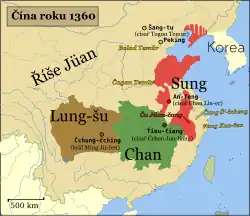Princess Lin'an
| Zhu Jingjing | |||||||
|---|---|---|---|---|---|---|---|
| Princess Lin'an | |||||||
| Born | 15 November 1360 | ||||||
| Died | July 30, 1421 (aged 60) | ||||||
| Burial | Tiexinqiao, Yuhuatai, Nanjing | ||||||
| Spouse | Li Qi | ||||||
| Issue | |||||||
| Father | Hongwu Emperor | ||||||
| Mother | Noble Consort Chengmu | ||||||
| Chinese name | |||||||
| Traditional Chinese | 臨安公主 | ||||||
| Simplified Chinese | 临安公主 | ||||||
| |||||||
| Personal name | |||||||
| Traditional Chinese | 朱鏡靜 | ||||||
| Simplified Chinese | 朱镜静 | ||||||
| |||||||
Princess Lin'an (15 November 1360[a] – 30 July 1421), personal name Zhu Jingjing,[b] was a princess of the Ming dynasty. She was the eldest daughter of the Hongwu Emperor and Noble Consort Chengmu.
Life

Zhu Jingjing was born on 15 December 1360,[a] as the eldest daughter of Zhu Yuanzhang. Her mother was Zhu Yuanzhang's concubine, Lady Sun (later Noble Consort Chengmu),[2] and she was the full older sister of Princess Huaiqing.[3] At the time, Zhu Yuanzhang was based in Nanjing and was a prominent leader in the Red Turban Rebellion, an uprising against the Mongol-led Yuan dynasty that controlled China. The rebellion aimed to restore Han Chinese rule after decades of Mongol domination. In the 1360s, Zhu Yuanzhang conquered China, established the Ming dynasty, and declared himself emperor.[4] He is commonly known by his era name as the Hongwu Emperor.[5]
On 26 July 1376, Zhu Jingjing was married to Li Qi, the son of Li Shanchang, Duke of Han. She was also granted the title of Princess Lin'an.[6] This marriage took place during a time when the wedding protocols for Ming princesses were just being established. As part of the ceremony, Li Qi was first granted ceremonial headgear, an official commission, and court robes, followed by a grand procession. The princess was known for diligently adhering to the moral codes expected of women. As the son of a meritorious official and the emperor's eldest son-in-law, Li Qi enjoyed significant trust from the Hongwu Emperor. He was frequently ordered to provide relief whenever floods or droughts struck various regions.[7]
On 6 July 1390, Li Shanchang was executed for his involvement in the Hu Weiyong case. Li Qi, who was spared from capital punishment due to his status as the emperor's son-in-law, was instead exiled to Jiangpu (present-day Pukou, Nanjing). Princess Lin'an accompanied him into exile, and Li Qi eventually died in Jiangpu.[c] Their sons were granted immunity from punishment.[1]
On 30 July 1421, Princess Lin'an died at the age of 60. Her older brother, the Yongle Emperor, suspended court audiences for four days in mourning.[8] Her tomb was discovered in May 2018 in Tiexinqiao Subdistrict, Yuhuatai District, Nanjing,[2] and was listed as a municipal-level cultural heritage protection unit in Nanjing in September 2023.[9]
Notes
- ^ a b "Epitaph of Princess Lin'an" recorded that Princess Lin'an was born on the 7th day of the 10th month in the Gengzi year. This date corresponds to 15 December 1360 on the Julian calendar.
- ^ "Epitaph of Princess Lin'an" records the princess's personal name as Zhu Jingjing.[2]
- ^ The History of Ming contains conflicting accounts regarding the death of Li Qi. The "Biography of Princess Lin'an" states that Li Qi died before his father, Li Shanchang, was executed in the Hu Weiyong case. However, the "Biography of Li Shanchang" records that Li Qi was still alive when his father was executed for his involvement in the case, subsequently moving with Princess Lin'an to Jiangpu, where he died years later.[7][1]
References
Citations
- ^ a b c d History of Ming, vol. 127.
- ^ a b c Zhu, Zhongxiu; Wang, Ni; Qi, Haining (21 June 2019). "南京发现明初怀庆公主墓临安公主墓". China Culture Relics Newspaper (in Chinese). China Cultural Relics News Agency. Archived from the original on 11 May 2023. Retrieved 27 July 2025.
- ^ Xuanzong Shilu, vol. 3.
- ^ Tsai (2002), pp. 20–21.
- ^ Chan, David B. "Hongwu". Encyclopædia Britannica. Retrieved 19 June 2011.
- ^ Taizu Shilu, vol. 100.
- ^ a b History of Ming, vol. 121.
- ^ Taizong Shilu, vol. 239.
- ^ Nanjing Municipal People's Government (14 September 2023). "市政府关于公布第五批市级文物保护单位的通知". Nanjing Municipal People's Government Bulletin (in Chinese).
Works cited
- Tsai, Shih-Shan Henry (2002). Perpetual Happiness: The Ming Emperor Yongle. Seattle, Wash.; Chesham: University of Washington Press; Combined Academic. ISBN 0295981245.
- Taizu Shilu 太祖實錄 [Veritable Records of Emperor Taizu] (in Literary Chinese).
- Taizong Shilu 太宗實錄 [Veritable Records of Emperor Taizong] (in Literary Chinese).
- Xuanzong Shilu 宣宗實錄 [Veritable Records of Emperor Xuanzong] (in Literary Chinese).
- Zhang, Tingyu (1739). Ming Shi 明史 [History of Ming] (in Literary Chinese).